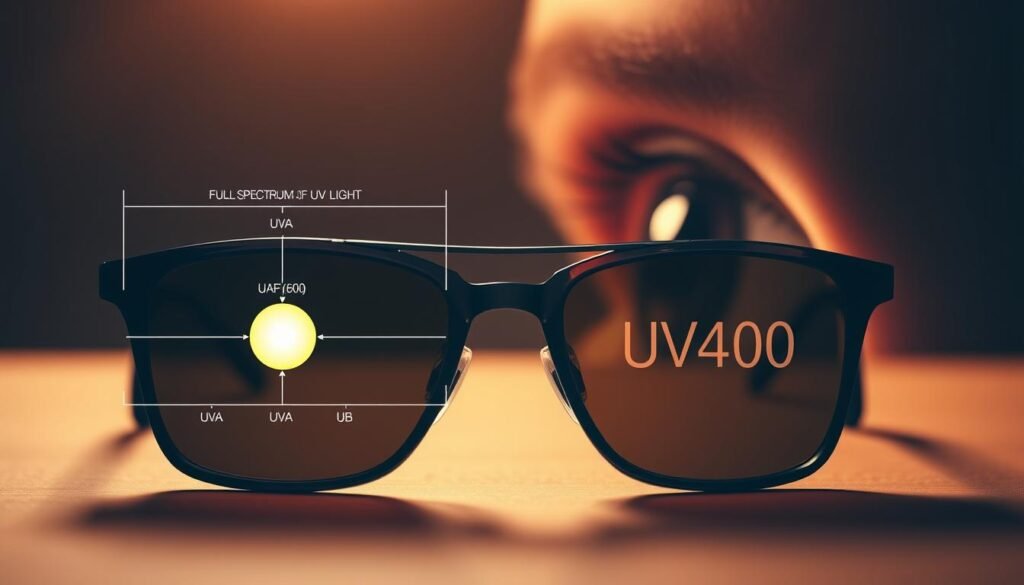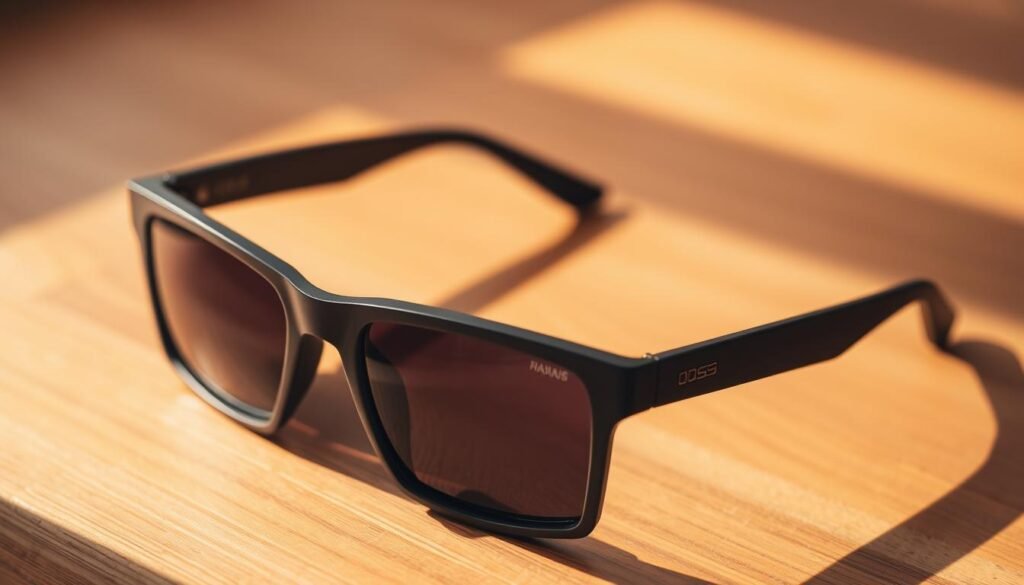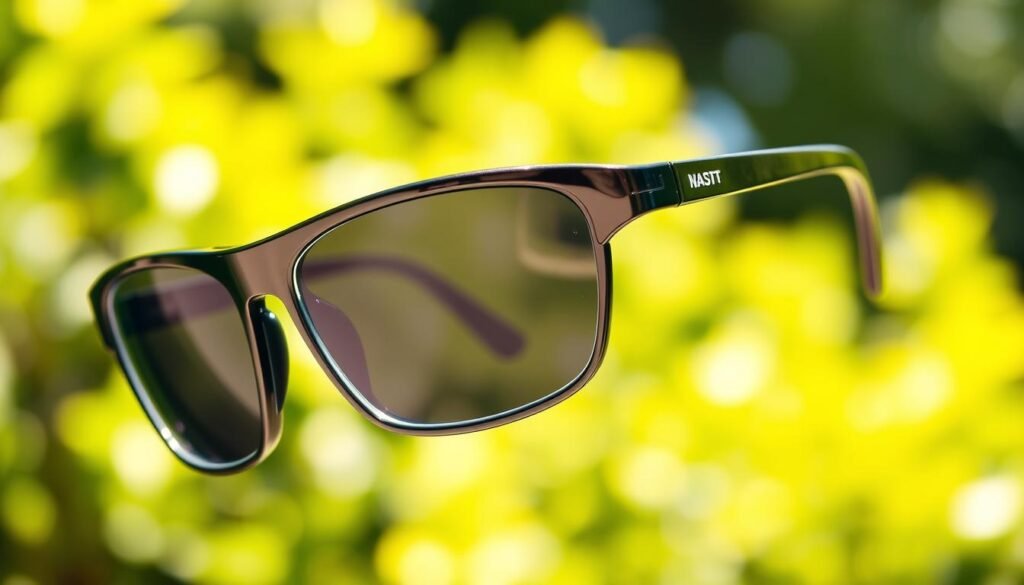Sunlight brings joy to outdoor adventures but hides invisible risks for your sight. Dr. Thomas Stokkermans, an ophthalmologist at All About Vision, states: “UV400-rated lenses block 99% to 100% of harmful UVA and UVB rays” – the benchmark professionals trust. Without proper shielding, short-term exposure can trigger painful photokeratitis, while cumulative damage raises risks for cataracts and macular degeneration.
Board-certified specialist Dr. Diane Hilal-Campo warns that “daily precautions are non-negotiable” against solar radiation. Many stylish options lack certified protection, letting rays penetrate dilated pupils. This creates higher danger than wearing no coverage at all.
Choosing eyewear isn’t just about blocking light. Polarized lenses reduce glare during driving or water activities, while wraparound designs prevent side-angle exposure. Quality matters: trusted brands meet strict optical clarity standards without distorting your view.
Key Takeaways
- UV400 blocks 99-100% of harmful rays, per leading ophthalmologists
- Uncertified shades may increase eye damage risks
- Polarization and full coverage enhance safety
- Balance style preferences with verified protection levels
- Invest in optical-grade lenses for clarity and durability
Understanding UV Protection and Its Importance
Sunlight’s invisible threats outlast temporary summer tans. Dr. Diane Hilal-Campo compares UV overexposure to “getting sunburned through your corneas,” creating immediate pain and hidden dangers. While beach days fade, radiation damage compounds silently year after year.
Two Levels of Defense
Photokeratitis strikes fast – think gritty eyelids and light sensitivity. This temporary condition masks deeper issues. “Each sun session adds invisible scars,” notes Dr. Hilal-Campo. Cumulative harm appears decades later as cataracts or macular degeneration.
Skin Meets Sight
Your eyelids need armor too. This delicate area suffers dual attacks:
- Premature wrinkles from collagen breakdown
- Increased cancer risks in thin facial skin
- Sunburned membranes causing chronic dryness
The World Health Organization reveals 80% of lifetime UV damage happens before adulthood. Cloudy days trick us – harmful rays penetrate clouds, reflecting off surfaces. Daily habits build your vision future: choose protection that works while you play, drive, or simply enjoy daylight.
Types of UV Rays and Their Effects on Eye Health
Not all sunlight reaches your eyes equally. Three types of ultraviolet radiation exist, each with distinct impacts. Knowing their differences helps you make smarter protection choices.
What Makes UVA and UVB Different?
UVA rays slip through Earth’s atmosphere unnoticed. These stealthy waves reach your retina, increasing risks for macular degeneration. “Think of them as silent vision thieves,” explains Dr. Hilal-Campo. Their damage builds slowly but permanently.
UVB radiation packs more immediate punch. These rays burn surface layers like your cornea, causing that gritty “sunburned eyes” feeling. Repeated attacks thicken eye lenses, raising cataract risks over decades.
Hidden Dangers of Bounced Light
Sunlight doesn’t just come from above. Surfaces around you act like mirrors:
| Surface | UVB Reflection | Risk Level |
|---|---|---|
| Snow | 94% | Extreme |
| Water | 8% | Moderate |
| Sand | 15% | High |
Winter sports enthusiasts face double trouble – direct and reflected rays. Half your total UV exposure comes from bounced light, even under clouds. That’s why quality coverage matters year-round.
sunglasses do eye doctors recommend for Optimal UV Protection
Quality sun protection starts with understanding technical specifications. Dr. Thomas Stokkermans clarifies: “UV400 indicates lenses block wavelengths up to 400 nanometers – the benchmark for 100% UVA and UVB defense.” This standard aligns with category 4 tinting, ideal for bright environments like beaches or snowy slopes.
Decoding Lens Certification Systems
Manufacturers use numbered categories to indicate visible light filtration:
- Category 0: Clear lenses for indoor use
- Category 2: Light tint for variable clouds
- Category 4: Darkest tint for extreme glare
Medical professionals emphasize checking labels for both UV400 marking and category ratings. Dr. Singh advises: “Match lens darkness to your activities – darker isn’t always better for daily wear.”

Smart Shopping Without Overspending
Effective radiation blocking doesn’t demand luxury prices. Many drugstore options meet medical-grade requirements when properly labeled. Focus on these elements:
- Clear “100% UVA/UVB” or “UV400” statements
- Wraparound styles minimizing peripheral exposure
- Impact-resistant materials for active lifestyles
Industry advancements make premium features accessible. Polarization and anti-reflective coatings now appear in budget-friendly models, proving safety and style coexist across price points.
Guide to Choosing the Right Sunglasses for Your Needs
Your ideal pair should feel like a natural extension of your daily life while guarding against solar threats. Dr. Singh simplifies the process: “Start with certified UV protection, then build outward based on your activities and aesthetic preferences.” Modern designs prove you don’t need oversized frames to get full coverage – clever engineering achieves both sleek profiles and safety.

Smart Lens Selection Strategies
Lens color plays a surprising role in visual comfort. Amber or brown tints boost contrast for those with macular concerns, while gray maintains true color perception during drives. Polycarbonate prescription options now come with built-in UV defense, merging vision correction and sun protection seamlessly.
Consider these factors when shopping:
- Frame width covering eyebrows to cheekbones
- Lightweight materials reducing pressure points
- Mirror coatings for high-glance environments
Activity-specific needs matter too. Water sports demand hydrophobic coatings, while urban commuters benefit from transition lenses adapting to shifting light. Reputable brands offer lab-tested options across styles – from cat-eye to aviator – ensuring your look matches your lifestyle without compromising safety.
Remember: dark tints don’t equal better protection. Check for 100% UV blockage labels regardless of lens shade. With today’s tech, your perfect match exists where medical-grade shielding meets personal flair.
The Role of Lens Features: Polarized, Photochromic, and More
Modern lens technology offers more than basic sun shielding. Advanced features address specific visual challenges while maintaining essential UV defense. Let’s explore how these innovations enhance comfort and adaptability.
How Polarized Lenses Reduce Glare
Dr. Thomas Stokkermans clarifies their function:
“Polarized sunglasses have a special coating that reduces glare from flat, reflective surfaces like water, snow, and roads, improving visual comfort and clarity.”
This technology works like microscopic blinds, filtering horizontal light waves that cause squinting and eye strain.
Key advantages include:
- Enhanced safety during driving (cuts dashboard reflections)
- Better visibility for water sports and snow activities
- Reduced fatigue during prolonged outdoor exposure
| Feature | Glare Reduction | UV Protection |
|---|---|---|
| Standard Lenses | 15% | 100% |
| Polarized | 90% | 100% |
| Photochromic | 70% | 100% |
Benefits of Photochromic and Transition Lenses
These light-responsive options eliminate frequent eyewear swaps. Dr. Singh notes: “Patients post-LASIK particularly benefit from adaptive lenses that maintain consistent protection.” They darken within seconds of UV exposure and clear indoors – perfect for commuters and office workers.
Modern versions now combine multiple technologies. Some premium options offer polarization alongside photochromic adjustments. Prescription wearers gain particular advantages with transition lenses that serve as regular glasses and sun protection in one pair.
Expert Recommendations and Trusted Brands
Selecting the right protective eyewear becomes simpler when guided by specialists and trusted manufacturers. Leading professionals emphasize technical specifications over trends, helping you balance safety with personal style.
Insights from Board-Certified Ophthalmologists
Ray-Ban and Wiley X dominate medical recommendations for consistent UV400 compliance. The Suncloud Aviator model delivers military-grade polarization under $60 – a “smart investment” according to optical experts. Wiley X’s shatterproof Romer 3 design shows how rugged frames can still look sleek.
Popular Brands and Editor Favorites
Style-conscious shoppers love Sungait’s vintage rounds offering full defense at $15. Woodies Walnut combines eco-friendly materials with polarized lenses for under $25. Dr. Hilal-Campo suggests grey-tinted options: “They maintain true colors while blocking harsh glare.”
Quality protection spans price ranges. Whether choosing Chamelo’s color-shifting tech or Warby Parker’s prescription-ready styles, prioritize verified UV labels. Your ideal pair awaits where medical standards meet everyday flair.

